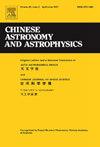Observation Simulation and Orbital Retrieval of the CHES Satellite
Q4 Physics and Astronomy
引用次数: 0
Abstract
So far, most of the exoplanets have been discovered with the radial velocity and transient methods. In comparison with these detection techniques, the astrometric method has unique advantages in the determination of planetary orbital parameters and masses. Closeby Habitable Exoplanet Survey (CHES) will search for terrestrial planets in the habitable zone around 100 sun-like stars in the solar system's neighbors (about 10 pc from the sun) using the micro-arcsecond space astrometry method, and further carry out a comprehensive census of nearby planetary systems to obtain the true mass of planets and three-dimensional orbital parameters to establish a complete database of the nearby planetary systems. Based on the observation mode and scientific objectives of the CHES satellite, this work conducted the simulated observations on Alpha Centauri A, a simulated solar system, 51 Peg, and the black hole Cyg X-1, and generated astrometric simulation data. Using two periodic spectra of Lomb-Scargle and BIC (Bayesian information criteria), the signal of the planetary orbit period is analyzed, and the orbit inversion of the planetary system is carried out with the Markov Chain Monte Carlo (MCMC) algorithm. In addition, this work further discusses the influence of the planets around the reference stars on the detection of habitable planets, and the BIC periodic spectrum can be used to identify the reference stars that may have planets around them.
CHES卫星的观测模拟与轨道反演
迄今为止,大多数系外行星都是用径向速度和瞬态方法发现的。与这些探测技术相比,天体测量法在确定行星轨道参数和质量方面具有独特的优势。近地宜居系外行星调查(CHES)将利用微弧秒空间天体测量方法,在太阳系附近(距离太阳约10pc)的100颗类日恒星周围的宜居带内寻找类地行星,并进一步对近地行星系进行全面普查,获得行星的真实质量和三维轨道参数,建立完整的近地行星系数据库。根据CHES卫星的观测模式和科学目标,对半人马座阿尔法星A、模拟太阳系、51peg和黑洞Cyg X-1进行了模拟观测,生成了天体测量模拟数据。利用Lomb-Scargle和BIC(贝叶斯信息准则)两个周期谱对行星轨道周期信号进行了分析,并采用马尔可夫链蒙特卡罗(MCMC)算法对行星系统进行了轨道反演。此外,本工作还进一步讨论了参考恒星周围行星对可居住行星探测的影响,BIC周期谱可以用来识别可能有行星围绕的参考恒星。
本文章由计算机程序翻译,如有差异,请以英文原文为准。
求助全文
约1分钟内获得全文
求助全文
来源期刊

Chinese Astronomy and Astrophysics
Physics and Astronomy-Astronomy and Astrophysics
CiteScore
0.70
自引率
0.00%
发文量
20
期刊介绍:
The vigorous growth of astronomical and astrophysical science in China led to an increase in papers on astrophysics which Acta Astronomica Sinica could no longer absorb. Translations of papers from two new journals the Chinese Journal of Space Science and Acta Astrophysica Sinica are added to the translation of Acta Astronomica Sinica to form the new journal Chinese Astronomy and Astrophysics. Chinese Astronomy and Astrophysics brings English translations of notable articles to astronomers and astrophysicists outside China.
 求助内容:
求助内容: 应助结果提醒方式:
应助结果提醒方式:


